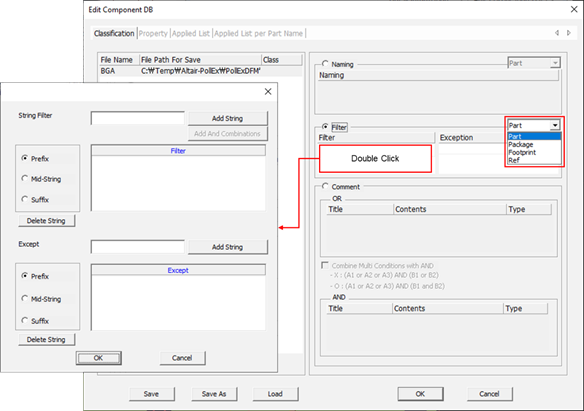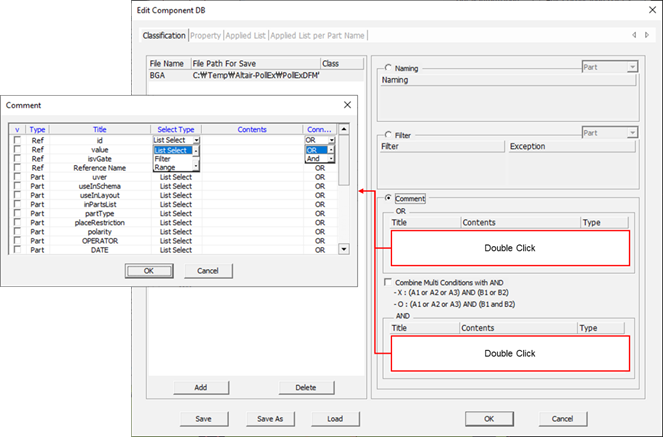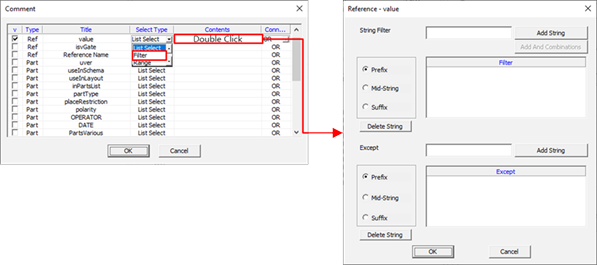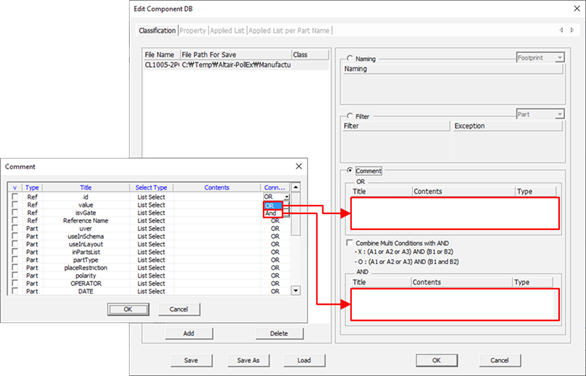Edit Classification DB
Use PollEx DFM to use component groups and classes in checking items.
- Component DB List: Show DB files list.
- File Name: Component DB files name.
- File Path for Save: Component DB files path.
- Class: Component DB class name.
- Add: Add a new component DB file (*.txt) to the list or create a new DB file. To add a new DB file, input a non-existing file name.
- Delete: Delete the selected list from the component DB list.
- Save: Save current setting in a *.pccls file.
- Save As: Save current setting in a *.pccls file with a different name.
- Load: Load saved setting file.
- Component DB Setting Window: Check or edit information for the selected
component DB list.
- Naming: Create DB with name (Refer to Naming).
- Filter: Create DB file with string (Refer to Filter).
- Comment: Create DB file with properties in component (Refer to Comment).
Naming

Figure 1.
- Component Name Selection Filter: Use this filter to set the filter type to be used to select components among part name, package name, footprint name, or reference name.
- Add: Double-click the naming field to open the Select Component From List dialog. From the list in Not Selected List, select components and add components in the upper list as selected component list.
- Remove: After selecting components in the selected component list, click Remove to remove the item from the list. Removed items are moved to the Not Selected List.
Filter

Figure 2.
- Component Filter: Set the filter type to be used to select components among part name, package name, footprint name, device name, and reference name.
- String Filter: Add the string to be included in the component classification database.
- Affix Filter: For the string added in the String Filter column, select its
usage type among prefix string, middle string, or suffix string in the
component name.
- Prefix: Component name should be started with the given string.
- Mid-String: Given strings should be in the component name.
- Suffix: Component name should end with the given string.
- Add String: With conditions in the String Filter and Affix Filter, make a filter and add it to the list.
- Add And Combination: For set filtering conditions, add conditions combination for String filter and Affix filter, with and without combination. For example, if you want to select components which name starts with SMD character string and ends with IC character string, use the following: After input SMD in string filter, select Prefix and click Add String. Then, input IC in the string filter, select Suffix for affix filter and click Add And Combination.
- Except String Filter: For the filer conditions generated by String filter to Add And Combination sections, input the character string you want to exclude.
- Affix Filter: For character string in Except String filter, select its usage
among Prefix, Mid-String or Suffix.
- Prefix: Component name should start with the given string.
- Mid-String: Given strings should be in the component name.
- Suffix: Component name should end with the given string.
- Add String: Add filer conditions to the list for filtering condition, set in Except String and Affix Filter.
Comment

Figure 3.
- V: Column for checking component properties will be used.
- Type: Show component property type.
- Title: Show property title.
- Select Type: Select component property setting method.
- List Select: Setting method by selecting properties list defined in design.
- Filter: Setting method by using string filter to set components that have matched properties.
- Range: Setting method by specifying the range when the property value is numeric.
- Contents: Open the Comment Select, String
Filter, or Range Setting dialog.
- List Select: Set the component group with the component’s property
value.

Figure 4. - Filter: Specify the parts within the numerical range when the
property value is numeric.

Figure 5. - Range: Set the component group with the components property
value.

Figure 6.
- List Select: Set the component group with the component’s property
value.
- Connected: Select OR or AND
combination.

Figure 7.- OR: In case of set property is matching with one of the component properties.
- AND: In case of set property is matching with the component properties in OR field and with component properties in AND field. For example, OR(A1, A2, A3), OR(B1, B2) means (A1 ∪ A2 ∪ A3) ∩ (B1 ∪ B2).
DB File Setting with ASCII Text Editor
The DB file is constructed with ASCII text string. You can make or edit it using notepad or a simple text editor.

Figure 8.
The first line in the component DB file is classification filter types.
[Part Name Filters]: Classification filter type is part name.[Package Name Filters]: Classification filter type is package name.[Footprint Name Filters]: Classification filter type is footprint name.[Reference Name Filters]: Classification filter type is reference name.
[Filter::Part Name]: Classification filter type is part name.[Filter::Package Name]: Classification filter type is package name.
[Property]